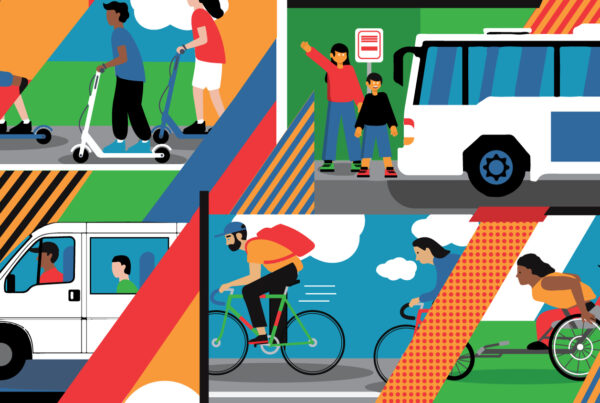When Santa Monica’s new Breeze Bikeshare system launched this last November, users were able to access a wealth of information – such as the number of bikeshare bikes available at each dock, alongside real-time arrival information for trains and buses – with just a few clicks of their phone.
Courtesy of a partnership between the City of Santa Monica, Transit App and bikeshare provider Social Bicycles, the real-time information was made available using a new open data standard called General Bikeshare Feed Specification, or GBFS.
The data standard was created to help make bikeshare data feeds publicly available online in a uniform format so that map and transportation-based apps such as Google Maps, RideScout and Transit App can easily incorporate the data into their platforms. Available GBFS data includes station locations, bike and dock availability, pricing information and more.
To develop GBFS, the North American Bike Share Association (NABSA) worked with the industry’s leading tech and equipment providers – including 8D Technologies, PBSC Urban Solutions, Social Bicycles, Bcycle, Smoove and Motivate – regularly over the past year. In its announcement, NABSA also noted that each of these companies agreed to implement the standard by the end of 2015.
“With more than fifty bikeshare systems launched in North America since 2010, bikeshare has quickly become an important part of our transportation ecosystem,” said Mitch Vars, a NABSA representative and IT director at Nice Ride MN, Minneapolis’ public bikesharing system. “Establishing an open data standard is an important step to making bikeshare ever more convenient and accessible to the public.”
The GBFS Revolution
The idea for GBFS came from a similar data standard called General Transit Feed Specification, or GTFS, which defines a common format for public transit schedules and associated data. GTFS was first developed by Bibiana McHugh, an IT Manager at TriMet in Portland, who was frustrated with the lack of online transit information for scheduling and route planning. She eventually got in touch with Google and ended up collaborating with its engineers to integrate TriMet’s data with Google Maps.
By making TriMet’s data open and compatible for developers, TriMet set a standard for other transit agencies looking to make route and schedule information more convenient and accessible for customers. Now, GTFS is available in roughly 800 cities and allows for people to easily plan their transit trips through third-party apps like Transit App and RideScout.
With an eye on GTFS, Vars considered developing a similar open data standard for bikesharing. At the first NABSA meeting in 2014, he organized a panel around GBFS and later helped develop a working group on the topic. During a meeting of the group at the 2015 Move Together National Shared-Use Mobility Summit last fall, NABSA was able to secure buy in for GBFS from North American bikeshare technology providers and operators, as well as gain the interest of city officials. NABSA officially announced the launch of GBFS in November 2015.
Coming to a City Near You
Although the bikesharing industry has unanimously agreed to the data standard, cities will have a choice on whether they want to opt in or not. According to Vars, however, city leaders have responded enthusiastically to GBFS so far and he expects that most, if not all, choose to use the data standard.
For cities with bikeshare systems that are provided through Bcycle or 8D Technologies, including Washington D.C., Boston, New York and Montreal, open bikeshare data is expected to be available early this year. Transit App also announced it will be integrating GBFS data from Social Bicycles in nine North American cities, including Santa Monica.
As for cities currently without bikeshare, but with plans to implement a system soon, Vars suggests GBFS will likely be required from the start through the request for proposal processes.
Shaping the Future of Bikesharing
“Creating a data standard opens up the opportunity for bikeshare systems to utilize all of the new applications that we couldn’t be a part of before,” said Vars. “GBFS will also have a huge impact on people in the research community, who will now be able to compare bikeshare use across cities, and know that the data is compatible and reliable.”
Transit agencies’ GTFS data has become a crucial tool for planners, who have used it when forecasting changes to transit networks or during planning processes that involve multiple modes of transportation. Independent research organizations like the Brookings Institution have also used GTFS to conduct studies that examine factors such as how well transit connects people with their jobs.
Similarly, researchers will now be able to use GBFS to able to track bikeshare trips in cities and determine when and how the service is actually being used, whether it’s for first/last mile connections to public transportation or short trips during times of peak transit capacity in dense urban centers.
Also, the addition of bikesharing to trip planning apps may help further increase its visibility and, ultimately, its use. For instance, someone using Google or RideScout to plan a trip to a downtown meeting might notice that bikesharing is actually the quickest way to reach his or her destination, and that there are several stations located nearby.
The next step for real-time multimodal planning apps is to incorporate payment integration for bikesharing along with others modes such as transit, carsharing and ridesourcing. However, progress has been made on the front as well. At the Move Together summit, TransitApp and PBSC Urban Solutions announced a new partnership that will enable mobile bikeshare payment and unlocking. Bcycle and RideScout also recently demonstrated the first use of a smartphone to unlock and pay for a bikesharing bike at Bcycle’s annual operator conference this past October.
For more information on the latest developments in bikesharing and open data, be sure to sign up for SUMC’s regular newsletter.
Image by Tony Webster



